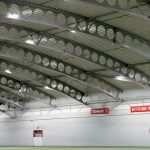Utilizing Cellular Beams for A Sustainable Building Materials
Climate change has become increasingly more important to focus on in recent years. While it’s difficult to know exactly how much of an impact we have had on the environment, we know ways to help turn the tide and reduce our overall carbon footprint on the planet. By reducing the production of plastics and other non-recyclable materials, we will help strengthen the ozone, which will help improve the protective barrier around the planet. This improved protective barrier will then help in the cooling of the planet as fewer sun rays will become trapped inside the earth’s atmosphere (sun rays normally bounce off the earth, but greenhouse gases prevent the sun’s radiation from escaping, which is why the temperature has continued to increase and the weather has become more sporadic).
To help build stronger, lighter, and more sustainable buildings, architecture firms and contractors around the world are looking for methods to cut down on material while improving the structural integrity of the construction. One such kind of sustainable building materials that is now being used is a cellular beam. Here is how cellular beams are helping in the world of sustainable building.
Aiding Your Construction In The World Of Sustainable Building
In order to cut down on any new construction’s carbon footprint and the number of greenhouse gases it gives off (either during construction, during the creation of materials for the building, or post-construction), it is important to turn to a variety of new sustainable building materials. Different buildings will need to rely on different sustainable construction materials. Taller buildings will need equipment that can twist, curve, and sway with the wind and other weather conditions without breaking. One of the best ways to enhance the structural integrity of a building and help it withstand high winds and other naturally occurring conditions is to take advantage of cellular beams.
Cutting The Carbon Footprint
One of the best ways to cut your manufacturing’s carbon footprint is to reduce the amount of material you use during production. A cellular high-strength steel beam does exactly that. It is not a solid, continual beam. There are aspects of the beam that are cut out, making it easier to run wiring, HVAC equipment, electrical, ducts, and all kinds of other equipment through the openings. It also makes it easier to shift with high winds.
Because there is less material used in the construction of these steel beams, it instantly slashes the amount of carbon monoxide created during the production of these beams.
When creating new beams for your particular facility, the amount of metal not used in the creation can be anywhere from 20 to 30 percent of what a traditional beam might use. This instantly cuts away a large chunk of your carbon footprint, just with the utilization of cellular beams instead of the larger, bulkier steel beams.
Less Wasted Space
With the utilization of cellular beams, you can run utility lines through the beams. By doing this, you don’t have to maintain additional space either below or above the beams for the utilities (like plumbing, electrical, or HVAC systems). Because you no longer need to have the added space for the floors and ceilings, you can better utilize space within the construction. Perhaps you will want to maintain the same height as what the building would have been with the larger space between floors. When this is the case, the ceilings can be higher up. Or, if you want to go further with the sustainable features of the new construction, you can keep the same floor size and simply capitalize on the reduced space in between the floors.
When there is less space between floors, it doesn’t take as much building material per floor. This is multiplied for every floor within the construction; if you are working on a 10-story building, that is ten times the amount of construction material savings you’ll take advantage of. As you cut down on the number of sustainable building materials used during the construction of the new building, you will instantly bring down the number of carbon gases produced during the manufacturing of the materials you would normally use. While it might not drop the building down to a carbon-neutral (at least during construction), every little bit counts. If you’re able to implement energy-producing elements within the building (such as solar or wind), you may be able to cut down on carbon production eventually and, after several years, reach a carbon-neutral state, which is partially aided thanks to the reduced amount of building materials you need.
And this reduced amount of sustainable building materials within your facility is all thanks to using cellular beams for a sustainable building. It’s rather amazing what taking advantage of one material can do for you. And this is just a single improvement you can take advantage of during the construction of any multi-level building. Think about how much more of an improvement you can make on the sustainability of your building when you switch to a half dozen (or more?) sustainable building upgrades. Even small upgrades can have a major impact. And if you’d like to learn more about how cellular beams or other material produced by our team here at C-Beams can help you craft a more sustainable building, we are a simple phone call or email away.
Help Your Business Create A Sustainable Building
If you’re currently planning a new construction, and you are looking for a way to reduce building weight while, at the same time, improve upon the strength of the construction, cellular beams are a viable option. To learn more about cellular beams and how these sustainable building materials may answer your construction needs, our staff here at C-Beams is here to help. Our staff is just a phone call away from addressing your questions to helping you get started with made-to-order beams for your project.






